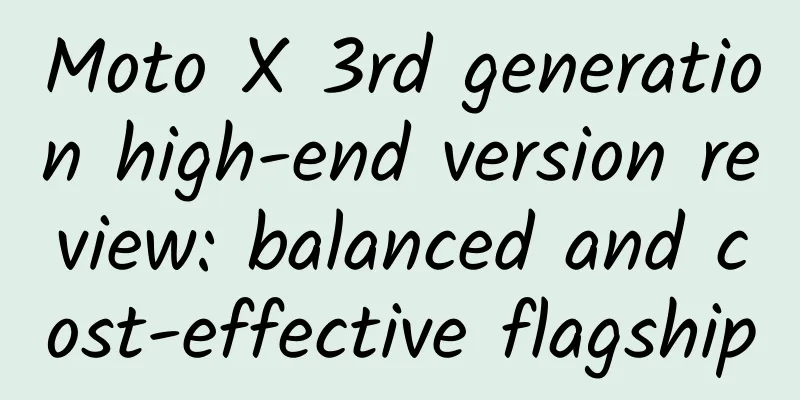Moto X 3rd generation high-end version review: balanced and cost-effective flagship

|
Motorola Mobility, a subsidiary of Lenovo, today released the third generation of Moto X. As a reporter for Sina Technology in the United States, I have not only attended almost all of Moto's press conferences, but also reviewed and witnessed every generation of Moto X. This year's third generation of Moto X gave me the feeling that Motorola finally made up for its biggest shortcoming of taking photos and launched a flagship model that is more balanced in all aspects. Unlike previous models, this year's third-generation Moto X is divided into a high-end version, the Style, and a low-end version, the Play. The Style is equipped with a 5.7-inch 2K screen and a Qualcomm 808 processor, while the Play is equipped with a 5.5-inch 1080P screen and a Qualcomm 615 processor. According to Jim Wicks, senior vice president of Moto, Moto will decide which Moto X to launch based on the different conditions of each market, for example, only the high-end Style will be released in the United States. Also different from previous years, this year Motorola did not provide the media with a review unit of the new X series products after the press conference, but instead provided a sample of the third-generation Moto G. Motorola said that the Moto X Style will not be available until September, and will be sent to the media for review at that time. Therefore, I could only experience the third-generation Moto X briefly on site. Design feel Motorola's mobile phone body design, material selection and grip feel have always been industry benchmarks. Different from the thin and fashionable design style of Apple iPhone, Motorola's design style emphasizes calmness and practical feel, especially the curved design on the back. This is also the logo design of Motorola. In my opinion, the first generation 4.7-inch Moto X is still the best in design, workmanship and feel in the X series, and perhaps the best smartphone to date. However, given that 5.7 inches is already the mainstream standard for flagship smartphones, it is not realistic to expect Moto to release a 4.7-inch model. In terms of hand feel, the third-generation Moto X (5.7-inch screen) is better than the second-generation (5.2-inch screen). Compared with the second-generation, although the third-generation has a much larger screen and volume, the back curve is more rounded and the upper and lower parts are more balanced. The third-generation Moto X is not bulky in the hand and is still the mainstream smartphone with the best hand feel. The third-generation Moto X has a new material called Coated Silicone Rubber on the back. This material feels very smooth and is resistant to dirt and wear. In addition, the third-generation Moto X also supports the Moto Maker personalized customization service, which supports more than ten different materials and colors, including various woods and leathers. Compared with the second generation, the metal frame and front panel of the third generation Moto X are not much different. The metal frame still feels smooth; the front panel also has two upper and lower speaker bars, but the third generation has an additional selfie flash next to the front camera. The screen-to-body ratio of the front panel reaches 76%, higher than the 68% of the iPhone 6 Plus and the 71% of the Samsung S 6. For the third generation Moto X, I personally think that the black panel looks better than the white one. Because on the white panel, the upper and lower speaker metal bars and many cameras, flashes and sensors will be very obvious. However, the color of the front panel should also match the overall style of the back. Unlike the huge circular flash and motorcycle logo on the back of the second-generation Moto X, the camera, dual-color temperature flash and the recessed logo of the third-generation Moto X are placed in a narrow metal strip similar to Lumia, and the recessed logo has returned to the size of the first generation. This design makes the third-generation Moto X look more compact. I am particularly satisfied with the design of the back. Hardware Parameters A flagship phone should have flagship features. Most of the hardware parameters of the high-end Moto X Style are top-notch in the industry, but like the LG G4, it uses Qualcomm's sub-flagship Snapdragon 808 chip; this is obviously due to the well-known heating problem of the Snapdragon 810 chip. Currently, most flagship phones using Qualcomm's 810 chip either suffer from heating problems or shrewdly reduce the frequency and shut down the core. There are few good solutions. Compared with Qualcomm's octa-core 810 chip, the 808 chip has two fewer cores, so its performance is indeed insufficient, but it wins in terms of balanced performance. Due to the use of the 808 chip, the third-generation Moto X has 3GB of memory, but it is enough to cope with daily needs. From my experience with LG G4, there is no obvious difference in experience between the 808 and the LG G4. The third generation Moto X has three storage options: 16GB/32GB/64GB, and surprisingly supports up to 128GB of Micro SD card expansion. This gives users more choices, which is obviously a plus. The screen was also a shortcoming of Moto X before. The AMOLED screen provided by Samsung on the first two generations of Moto X could hardly be said to be at the flagship level. This year's third generation high-end version of Moto X has a 5.7-inch QHD LCD screen with a resolution of 1440x2560. Perhaps because Moto X was not originally known for its screen, compared with the second generation Moto X, the third generation Moto X has a much better visual experience and its borders are also narrower. In addition, the intelligent voice assistant, active display, and intelligent scene mode switching are all plus factors for the Moto X series. This advantage is still retained and improved in the third-generation Moto X. Battery photography Previously, the most entangled issues of Motorola mobile phones were camera and battery. Although there were also battery behemoths in the Droid series, the battery life of the first two generations of Moto X was a bit disappointing, mainly because the battery capacity was too small and power-consuming functions such as active display. The third generation Moto X has significantly increased the battery capacity, with the high-end version and low-end version having a battery capacity of 3000 mAh and 3630 mAh respectively. At the press conference, Moto executives showed a comparison of the fast charging of the Moto X high-end version and the Samsung S 6. The Moto X high-end version has a significantly faster charging speed, with 15 minutes of charging providing 10 hours of use. According to Moto's publicity, this is the fastest charging smartphone on the market. The battery of the third-generation Moto X Style can last a whole day, and the battery of the low-end Moto X Play can last two days. Photographing is a long-standing problem for Motorola, which has always troubled Motorola fans. Motorola has not avoided this problem and has been working hard to improve it. Starting from last year's Droid Turbo and Moto X Pro, the photography of Motorola flagship phones has gradually approached the industry's first-class level. This time, Motorola executives have very loudly declared that the photography of the third-generation Moto X has reached the best level in the industry, and even put forward the slogan of "top three in the industry". The third generation Moto X uses a 21-megapixel back-illuminated CMOS, with a 1/2.4-inch sensor, dual LED flash, and a 5-megapixel front camera. When I asked if this camera was the same as the one on the Droid Turbo, Moto executives denied the speculation. They said that the focus speed, image quality, and low-light shooting of the third generation Moto X are far higher than those of previous Moto models, and it is the best camera level of Moto at present. Since Motorola did not provide a review unit for the third-generation Moto X, I could only take a few photos on site. Although I could not get a specific photo-taking experience, under indoor conditions, the low-light photography purity of the third-generation Moto X is obviously better than that of the Nexus 6 in my hand, and is also higher than that of the previous second-generation Moto X. According to the evaluation report of the industry authority DxOMark (http://connect.dpreview.com/post/3318468090/dxomark-mobile-report-motorola-moto-x-style), the Moto X high-end version scored 83 points (out of 100) for photography, ranking third among smartphones, just lower than the Samsung Note 4 and Samsung S 6Edge, and even higher than the iPhone 6 Plus. It performed particularly well in white balance. Even for Moto fans, this evaluation result is very surprising. Due to the industry credibility of DxOMark, I believe that the third-generation Moto X's photography has indeed improved significantly, at least reaching the mainstream level of the industry. In other words, photography is no longer a demerit factor for the third-generation Moto X, and Moto fans can buy it with confidence. Summarize: Motorola, once a giant in the industry, still has many loyal users in China, and has become a niche boutique manufacturer. Although the parameters of the Moto X series products are not gorgeous and there is an obvious weakness such as photography, the actual grip and use experience are pleasantly surprised. The third-generation Moto X not only maintains its unique design, but also makes up for the weakness of photography, which will make the Moto X series more attractive. Perhaps the biggest difference between the third-generation Moto X and other flagships is the lack of fingerprint recognition. The answer from Moto executives is that fingerprint recognition technology is not mature at present and Moto will continue to evaluate solutions. However, considering that the third-generation Moto X is only priced at $400, far lower than the $650 flagships of Samsung and Apple, Moto X is still a very cost-effective flagship of international manufacturers. Now that Moto is a subsidiary of Lenovo, China has once again become a key market for Moto. Moreover, Moto's position within Lenovo's mobile business group is also rising. I believe that we won't have to wait long before the third generation Moto X is officially released in China. As a winner of Toutiao's Qingyun Plan and Baijiahao's Bai+ Plan, the 2019 Baidu Digital Author of the Year, the Baijiahao's Most Popular Author in the Technology Field, the 2019 Sogou Technology and Culture Author, and the 2021 Baijiahao Quarterly Influential Creator, he has won many awards, including the 2013 Sohu Best Industry Media Person, the 2015 China New Media Entrepreneurship Competition Beijing Third Place, the 2015 Guangmang Experience Award, the 2015 China New Media Entrepreneurship Competition Finals Third Place, and the 2018 Baidu Dynamic Annual Powerful Celebrity. |
<<: 8 reasons not to upgrade to Windows 10 yet
Recommend
Xu Xian's favorite "Suzhen", scientists went through hardships to discover it
After years of investigation and sample research,...
Baidu Maps' new energy navigation function is newly upgraded on May 1: real-time dynamic reminders to solve the problem of "difficult charging" for car owners
It is the peak travel season for May Day again, a...
What is superconductivity? Believe me, you will definitely understand it in this article
Superconductivity is a "star" in the ph...
Exaggerated! World famous paintings have been hanging upside down for 75 years? What do scientists say about aesthetics?
Recently, the art world has made a ridiculous &qu...
Everyone is talking about communities, how do we build them? How to operate a community? How to monetize the community?
Products must be innovative, solve problems and r...
Double 11 is coming, how to rely on private domain traffic for marketing?
In the article shared today, we combined the cont...
Will mobile phones be equipped with Beidou navigation? Where else have we deployed Beidou?
Recently, a digital blogger revealed that the hig...
Front-end: 6 common HTML5 misuses
1. Don’t use section as a replacement for div One...
Google: Android TV games will disrupt Sony, Microsoft, and Nintendo
In the early days of the video game industry, com...
2021 Ma Bingbing Golden March and Silver April Interview Crash Course
2021 Ma Bingbing Golden March and Silver April In...
LG officially announces its exit from smartphone business
LG said in a regulatory filing that its mobile co...
High-nickel batteries become a new track, and the power battery industry is still full of variables
With the help of favorable policies and subsidies...
Customs intercepted a 4-meter-long giant king cobra! Netizen: A close-up view made me stunned
Recently, Zhangjiagang Customs under Nanjing Cust...
Will you become ugly if you work too long? How to say goodbye to "being ugly due to fatigue"?
Today I accidentally found my school photos. The ...
Can a few black dots say goodbye to motion sickness?
Motion sickness, medically known as "motion ...









